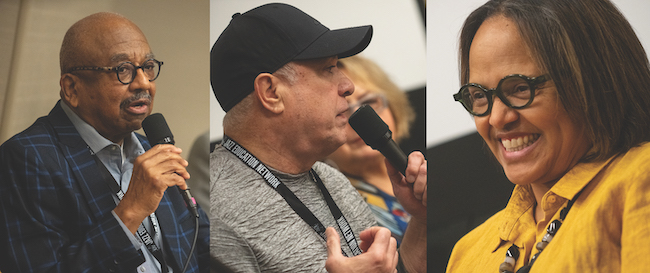Dec 9, 2025 12:28 PM
In Memoriam: Gordon Goodwin, 1954–2025
Gordon Goodwin, an award-winning saxophonist, pianist, bandleader, composer and arranger, died Dec. 8 in Los Angeles.…

Duane Davis (left), Oscar Hernandez and Terri Lyne Carrington at this year’s JEN Conference in New Orleans.
(Photo: Frances Scanlon)There are times when you listen to jazz musicians reveal the stories behind their lives and careers, and you can’t help but drop your jaw and say, “Wow.”
Such was the case during a panel discussion at the Jazz Education Network Conference in New Orleans this past January. When JEN co-founder Mary Jo Papich moderated a panel of LeJENds of Jazz (artists and educators who received the organization’s top honors this year), an awe-inspiring world of humble beginnings, God-given talent and unlocked potential came into view.
Terri Lyne Carrington, the drummer, composer, educator and change agent who received this year’s LeJENd of Jazz Education Award, has been leading a charge for inclusivity in jazz that has dramatically changed the way we think about who should be on the bandstand. As the founder and artistic director of the Berklee College of Music Institute of Jazz and Gender Justice, Carrington said that schools of music need to look beyond the norms sometimes to find students with special voices that just need to be developed. But as a champion of women and non-binary musicians in jazz, she also wants to be careful not to put them in a box.
“I think it’s good to start thinking about, because it’s easy to silo women,” Carrington said about women-specific jazz awards and programs. “[Terms like] ‘sisters in jazz’ or ‘women in jazz’ put them in a box sometimes. What is needed in the music is more gender equity, and not like women over here or women over there. … That’s the cultural transformation: gender equity.”
“The perspective that Terri Lyne shared is priceless,” said Oscar Hernandez, leader of the Spanish Harlem Orchestra and recipient of the LeJENd of Latin Jazz award. “Because it’s thinking outside the box, in terms of impacting people’s lives that would normally not be impacted, on some level.
“I’m originally from the South Bronx. We were a very poor family of 11. And I say — kind of figuratively, but in a sense literally — music saved my life.
“There were dynamics that were happening, especially the cultural revolution of Latinos in the ’60s, stemming from the ’40s and ’50s and the music of Tito Puente, Machito and Tito Rodriguez — the big three — which, from my perspective, is the equivalent of Duke Ellington and Count Basie on its own level.”
Hernandez could have been just another overlooked kid, but he found music, and mentors, and somehow made his way to leading one of the world’s most renowned Latin jazz bands.
“I feel that there’s a spiritual, divine intervention that I can’t explain,” he said. “Even the fact that I play piano, I can’t even explain it. Because we certainly couldn’t afford to buy a piano when when I was a kid. That was kind of out of the realm of reality.”
The messages delivered by Carrington and Hernandez resonated with vocalist and educator Duane Davis, recipient of the Ellis Marsalis Jr. Jazz Educator of the Year award.
“I had so many people who didn’t believe in me, that I had the potential to be a musician,” Davis said. “So, when I finished high school, I just worked on the railroad with my father, making more money than he did, because I had typing skills and shorthand skills. I was the first African American hired in the clerical department.
“But during that year, my high school music teacher said, ‘You should be in college. You should be in music.’ I was always in music, but we didn’t have a piano, like Oscar said of his family, and everything I learned, I learned by ear. But she could see deeper in me; she saw possibilities.
“When she saw that, I was so thankful, because I can remember [many years later] sitting in a faculty meeting at the community college, and they were rejecting some students. And tears came to my eyes and I said, ‘You cannot reject that student. I was that student. There are possibilities there. We have to find what’s going to unlock that kid.’”
That’s what jazz is all about. Finding the key. DB

Goodwin was one of the most acclaimed, successful and influential jazz musicians of his generation.
Dec 9, 2025 12:28 PM
Gordon Goodwin, an award-winning saxophonist, pianist, bandleader, composer and arranger, died Dec. 8 in Los Angeles.…

Nov 13, 2025 10:00 AM
For results of DownBeat’s 90th Annual Readers Poll, complete with feature articles from our December 2025 issue,…

Flea has returned to his first instrument — the trumpet — and assembled a dream band of jazz musicians to record a new album.
Dec 2, 2025 2:01 AM
After a nearly five-decade career as one of his generation’s defining rock bassists, Flea has returned to his first…

“It’s a pleasure and an honor to interpret the music of Oscar Peterson in his native city,” said Jim Doxas in regard to celebrating the Canadian legend. “He traveled the world, but never forgot Montreal.”
Nov 18, 2025 12:16 PM
In the pantheon of jazz luminaries, few shine as brightly, or swing as hard, as Oscar Peterson. A century ago, a…

Dec 11, 2025 11:00 AM
DownBeat presents a complete list of the 4-, 4½- and 5-star albums from 2025 in one convenient package. It’s a great…